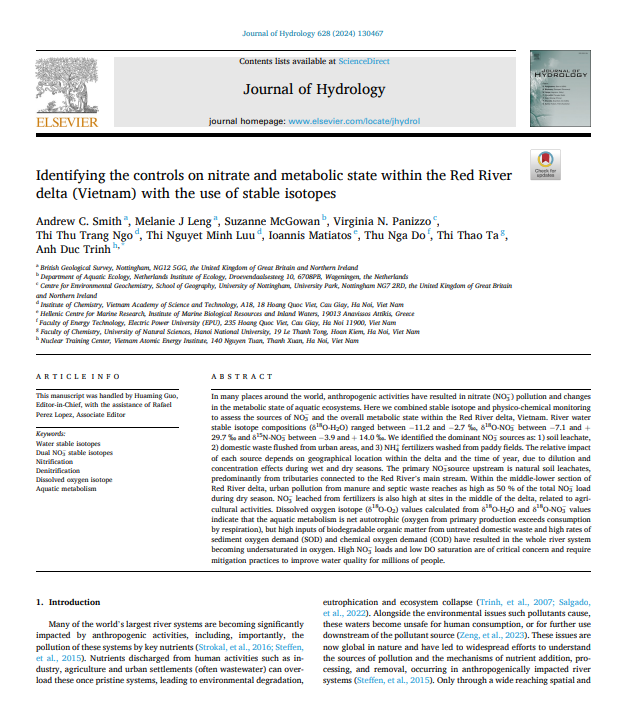Identifying the controls on nitrate and metabolic state within the Red River delta (Vietnam) with the use of stable isotopes
by Andrew C. Smith, Melanie J Leng, Suzanne McGowan, Virginia N. Panizzo, Thi Thu Trang Ngo, Thi Nguyet Minh Luu, Ioannis Matiatos, Thu Nga Do, Thi Thao Ta, Anh Duc Trinh
Abstract
In many places around the world, anthropogenic activities have resulted in nitrate (NO3−) pollution and changes in the metabolic state of aquatic ecosystems. Here we combined stable isotope and physico-chemical monitoring to assess the sources of NO3− and the overall metabolic state within the Red River delta, Vietnam. River water stable isotope compositions (δ18O-H2O) ranged between −11.2 and −2.7 ‰, δ18O-NO3− between −7.1 and + 29.7 ‰ and δ15N-NO3− between −3.9 and + 14.0 ‰. We identified the dominant NO3− sources as: 1) soil leachate, 2) domestic waste flushed from urban areas, and 3) NH4+ fertilizers washed from paddy fields. The relative impact of each source depends on geographical location within the delta and the time of year, due to dilution and concentration effects during wet and dry seasons. The primary NO3−source upstream is natural soil leachates, predominantly from tributaries connected to the Red River’s main stream. Within the middle-lower section of Red River delta, urban pollution from manure and septic waste reaches as high as 50 % of the total NO3− load during dry season. NO3− leached from fertilizers is also high at sites in the middle of the delta, related to agricultural activities. Dissolved oxygen isotope (δ18O-O2) values calculated from δ18O-H2O and δ18O-NO3− values indicate that the aquatic metabolism is net autotrophic (oxygen from primary production exceeds consumption by respiration), but high inputs of biodegradable organic matter from untreated domestic waste and high rates of sediment oxygen demand (SOD) and chemical oxygen demand (COD) have resulted in the whole river system becoming undersaturated in oxygen. High NO3− loads and low DO saturation are of critical concern and require mitigation practices to improve water quality for millions of people.

